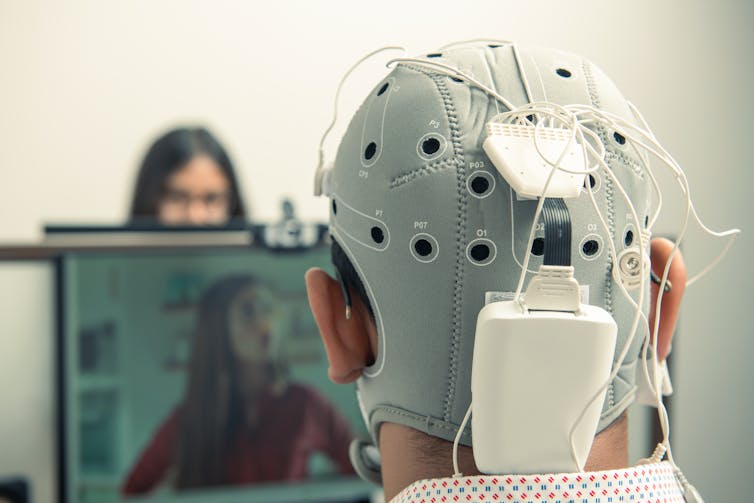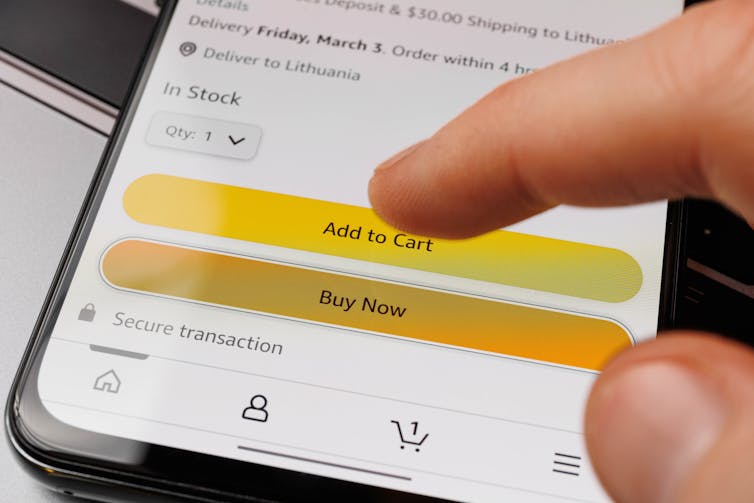Source: The Conversation (Au and NZ) – By Tijl Grootswagers, Senior Research Fellow in Cognitive Neuroscience, Western Sydney University
You are standing in the cereal aisle, weighing up whether to buy a healthy bran or a sugary chocolate-flavoured alternative.
Your hand hovers momentarily before you make the final grab.
But did you know that during those last few seconds, while you’re reaching out, your brain is still evaluating the pros and cons – influenced by everything from your last meal, the health star rating, the catchy jingle in the ad, and the colours of the letters on the box?
Our recently published research shows our brains do not just think first and then act. Even while you are reaching for a product on a supermarket shelf, your brain is still evaluating whether you are making the right choice.
Further, we found measuring hand movements offers an accurate window into the brain’s ongoing evaluation of the decision – you don’t have to hook people up to expensive brain scanners.
What does this say about our decision-making? And what does it mean for consumers and the people marketing to them?
What hand movements tell us about decision-making
There has been debate within neuroscience on whether a person’s movements to enact a decision can be modified once the brain’s “motor plan” has been made.
Our research revealed not only that movements can be changed after a decision – “in flight” – but also the changes matched incoming information from a person’s senses.
To study how our decisions unfold over time, we tracked people’s hand movements as they reached for different options shown in pictures – for example, in response to the question “is this picture a face or an object?”
When choices were easy, their hands moved straight to the right option. But when choices were harder, new information made the brain change its mind, and this was reflected in the trajectory of their hand movements.

Zero Degree 247/Shutterstock
When we compared these hand movement trajectories to brain activity recorded using neuroimaging, we found that the timing and amount of evidence of the brain’s evaluation matched the movement pattern.
Put simply, reaching movements are shaped by ongoing thinking and decision-making.
By showing that brain patterns match movement trajectories, our research also highlights that large, expensive brain scanners may not always be required to study the brain’s decision evaluation processes, as movement tracking is much more cost-effective and much easier to test on a large scale.
What does this mean for consumers and marketers?
For consumers, knowing our brains are always reevaluating decisions we might think of as “final” can help us be more aware of our choices.
For simple decisions such as choosing a breakfast cereal, the impact may be small. Even if you have preemptively decided on a healthy option, you might be tempted at the last minute by the flashy packaging of a less healthy choice.
But for important long-term decisions such as choosing a mortgage, it can have serious effects.

Rokas Tenys/Shutterstock
On the other side of the coin, marketers have long known that many purchase decisions are made on the spot.
They use strategies such as attractive packaging and strategic product placement to influence people’s decisions.
New ways of studying how people’s brains process information – right up to the last minute – can help marketers design more effective strategies.
Opportunities for further research
Further research in this area could explore how different types of information, such as environmental cues or memories, affect this continuous decision evaluation process in different groups of people. For example, how do people of different ages process information while making decisions?
Our finding – that hand movements reflect the inner workings of the brain’s decision making process – could make future studies cheaper and more efficient.
The ability to fine-tune marketing in this way has implications beyond just selling products. It can also make public strategic messaging far more effective.
This could include tailoring a public health campaign on vaping specifically for people aged under 30, or targeting messaging about superannuation scams more effectively at those of retirement age.
The act of reaching for a product is not a simple consequence of a decision already made; it’s a highly dynamic process. Being aware of what influences our last-minute decision-making can help us make better choices that have better outcomes.
![]()
Tijl Grootswagers receives funding from The Australian Research Council (ARC).
Manuel Varlet receives funding from The Australian Research Council (ARC).
Genevieve L Quek does not work for, consult, own shares in or receive funding from any company or organisation that would benefit from this article, and has disclosed no relevant affiliations beyond their academic appointment.
– ref. Think you’ve decided what to buy? Actually, your brain is still deciding – even as you put it in your basket – https://theconversation.com/think-youve-decided-what-to-buy-actually-your-brain-is-still-deciding-even-as-you-put-it-in-your-basket-234167









